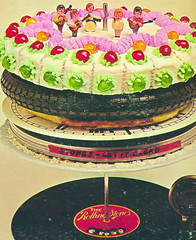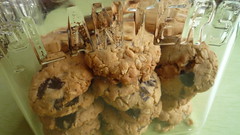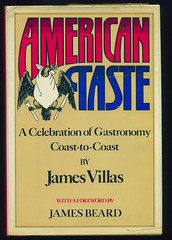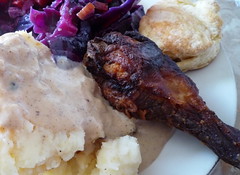So you want to feed a rock 'n' roll band?
 fig. a: what, no keyboardist?
fig. a: what, no keyboardist?
I wanna destroy you
I wanna destroy you
I wanna destroy you
I wanna destroy you
--"I Wanna Destroy You," The Soft Boys
Skeedle Lee Doo
That's all I do
--"Skeedle Lee Doo," Blind Blake
Then listen now to what I say:
Our friend C. once threw the travelin'-band meal to end all travelin'-band meals. A certain band she was fond of was coming to town. She wrote to them and invited them to stop by pre-gig and enjoy a meal at her place. They accepted. She cooked for an entire week. The prep filled two refrigerators. I know because one of them was mine. Then something happened and things didn't quite work out. Some of us still managed to enjoy the meal. A year or two later the band returned. C. had moved into this very apartment by that time. She got back in contact with said band and reinvited them. They reaccepted. She cooked for another entire week. This time things came off without a hitch. You shoulda seen the looks on the faces of said band. Awestruck. I'd tell you more, but it's a great story and I'm hoping that C. posts it herself on her blog. I'm picturing the menus. Both of them.
Anyway, inspired by our friend C. we devised a simplified three-point plan for entertaining a visiting rock 'n' roll band.
1. Drinks
Beer, wine, water, and peppermint tea. The first three are self-explanatory. You won't find any mention of that last substance in the pages of Hammer of the Gods (at least, I don't think you will--it's been a while), but it pays to have some on-hand (along with some honey) in case the lead singer shows up having lost his or her voice. Throat lozenges are a good idea too. Thayer's Slippery Elm, for instance. Although apparently Jonathan Richman uses Zand HerbaLozenges and, after 40 years in show business, he ought to know.
2. Home-cooked meal
Two words: comfort food. Two more words: spicy goodness. I've been all about the roux recently. I just can't wait to mix flour and fat and whip up some Cajun magic. So when I tried to imagine what kind of meal I might want to find if I was on the road, Chicken and Sausage Gumbo came to mind. It seemed like some pretty comforting comfort food for a hard-workin' band to arrive to.
Chicken and Sausage Gumbo
1 3-lb chicken, cut into pieces
salt, black pepper, cayenne pepper
1/4-lb smoky bacon
cooking oil
1/2 cup all-purpose flour
4 medium onions, chopped
1 cubanelle or Italian frying pepper, seeded and chopped
2 stalks celery (including the leaf), minced
1 pound Cajun andouille, kielbasa, or chorizo sausage, sliced thin (we used chorizo because that's the neighborhood specialty and Cajun cuisine is nothing if not pragmatic)
1 bunch scallions, minced
2 or 3 cloves garlic, minced
several sprigs fresh parsley
1/2 tbsp smoky chili powder
1 tbsp filé powder
steamed rice
Season the chicken pieces with salt and pepper. In a large, heavy-duty cast-iron skillet, cook the bacon over medium to medium-high heat until the fat has been rendered and the bacon is crispy. Remove the bacon, set aside, mince when cool enough to handle, and reserve. Brown the chicken pieces in the fat for a few minutes on each side, until you've crisped the skin and given it a nice color. Remove the chicken and set it on paper towels to cool. Eyeball the amount of fat in the skillet, and the combined bacon fat and chicken fat doesn't appear to be about 1/2 cup's worth, add cooking oil to bring the amount of fat in the skillet to 1/2 cup and bring to temperature. Add the flour and make a true Cajun roux, taking the time so that it becomes mahogany (or darker) and taking the care to make sure it doesn't get scorched. When the roux is to your liking, add the chopped onion, cubanelle pepper, and celery, and simmer until the onion is translucent, stirring occasionally. After this stage, transfer the roux mixture to a large pot, bring to temperature, add the sausage and cook for a minute or two before adding the chicken pieces and the minced bacon. Cover and simmer for 15 minutes, stirring occasionally. Meanwhile bring 4 cups of water to simmer in a pot or kettle.
When the chicken and sausage combo has simmered for 15 minutes, pour the simmering water into the pot and stir in the scallions, garlic, parsley, and chili powder. Turn up the heat and bring the mixture to a boil, then turn the heat down low and simmer the gumbo gently for about 1 1/2 hours, or until the chicken slips easily from the bone. Remove the chicken pieces, debone them, discard the skin, and shred coarsely, then return the meat to the pot. Just before serving sprinkle the filé powder in and stir in gently. Remove from the heat and let rest for 5 minutes. Serve in deep bowls with steamed rice.
Serves an entire band and then some generously.
[recipe inspired by John Thorne's Chicken-Andouille Gumbo from Serious Pig]
You're going to need rice to go along with the gumbo anyway, so it makes sense to cook up a rice-friendly vegetarian option that has a similar warmth to it, just in case. Take Mexican Lentil Soup, for instance, a keeper of a recipe that we first featured in 2005.
Throw in a batch of cole slaw, and you've got yourself a complete meal.
3. Cookies
Go behind the scenes in the high-end restaurant world and you'll find that there's this whole annihilation fantasy that's a big part of the biz. Basically, some VIP party shows up, the kitchen finds out, and, led by the chef, they set out to "destroy" them. When the VIP party includes other restaurant biz people the stakes go higher. Way higher. It's kind of a combination punch. You're trying to slay these VIPs with the quality of your gastronomy. You're also trying to slay them with sheer quantity. Again, if the VIPs are restaurant people, especially fellow chefs, we're talking an all-out potlatch of destruction. Or so Michelle tells me.
Michelle designed these cookies with this annihilation fantasy in mind. She wanted the cookies to "give [a rock band] energy," but, let's face it, she also wanted them to be killer.
 fig. b: peanut-butter destroyers just waiting to do what they do best
fig. b: peanut-butter destroyers just waiting to do what they do bestPeanut Butter Destroyers
3 sticks butter
2 cups rolled oats
1 1/2 tsp vanilla
2 tsp baking soda
1/4 tsp salt
3/4 cup sugar
3/4 cup brown sugar
3/4 cup crunchy peanut butter
2 1/4 cups all-purpose flour
100 g dark chocolate, coarsely chopped
Preheat the oven to 350º F.
Melt one stick of butter in a saucepan, add the oats, and toast them until golden and fragrant. Set aside to cool. Cream the remaining butter with the sugar and the brown sugar until light and fluffy. Add the vanilla and peanut butter and mix well. Add the flour, baking soda, and salt and mix. Finally, add the chocolate and the oats and mix until the dough comes together.
Drop the dough by tablespoons onto a parchment-lined baking sheet and bake 12-14 minutes until the bottoms are lightly golden. Cool on a rack.
Makes approximately four dozen cookies.
As it happens, some rock 'n' roll band friends of ours rocked and rolled through town just recently, so we tried out the menu on them.
Later, with bellies full, we headed down to a local rock 'n' roll club just in time to catch the last few songs by opening band #2, and not long before the headliners took the stage.
Having arrived late, we didn't exactly have the best view in the house,
 fig. c: mirror-ball madness
fig. c: mirror-ball madnessbut the meal seemed to have worked because the band sure sounded great. And every once in a while, with the help of a high-powered lens, we caught a glimpse of the theatrics on stage.
 fig. d: rip this joint!
fig. d: rip this joint!aj














